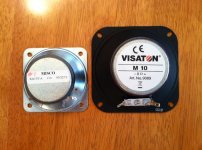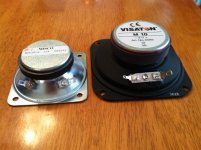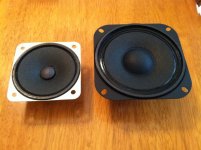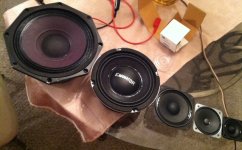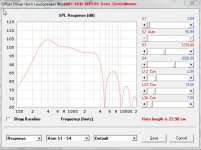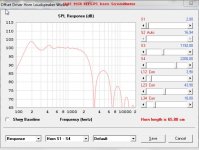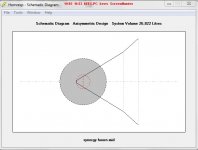Thomas,The reason I'm going sealed is that I have the impression that this alignment shows better transient behavior than relflex, or am I missing something?
Sealed should have better transient behavior in the low crossover region than reflex (though 1/2 the speakers in a bass reflex could achieve about the same SPL ), and the Beta does look better than the Alpha in the sim.
Since it is your money, I recommend the most expensive solution
Art
Since it is your money, I recommend the most expensive solution.
Art
I did a export with hornresp, but in sketchup and with use off push pull I do not get the angles right, but it do go very strange when try to push pull it making open corners and not a nice closed angle, yeahh it is difficult to explane, my technical english is not so well.
Ohh yeah, it is a test from a simulation, so don,t get to serieus about it, i did let see what I get when export through hornresp, the last flare hornresp make a error, or better, hornresp is not made to do that, I have write david about it, maybe he find it interesting to implement.
regards
kees

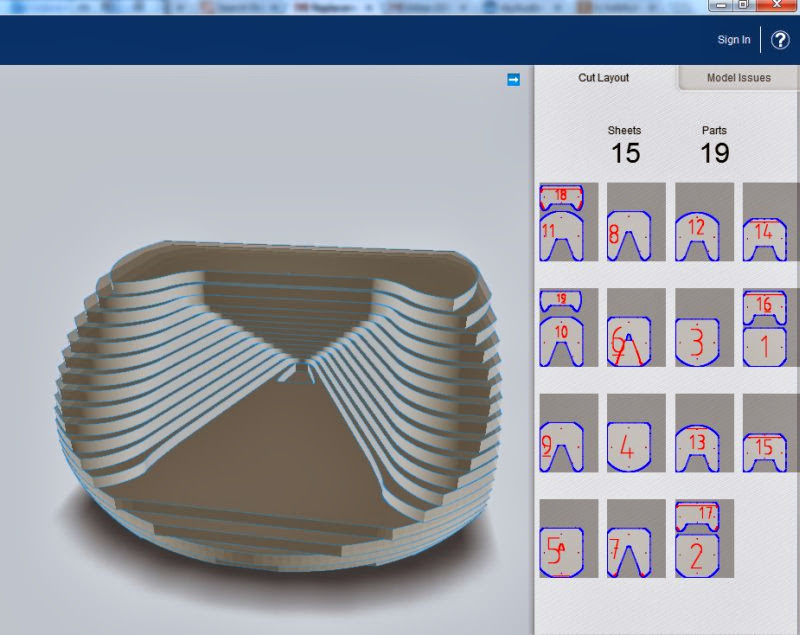
I just published a thread on how to make waveguides in Autodesk 123D design, then print them with Autodesk 123D Make.
Might be of interest to you.
http://www.diyaudio.com/forums/multi-way/243360-no-more-monkey-coffins.html
Patrick,I just published a thread on how to make waveguides in Autodesk 123D design, then print them with Autodesk 123D Make.
What is the cost of a three-D printer capable of printing out a 28" x 28" x 22.5" horn, and what would the cost of plastic printing materials be for 3/4" thickness on the horn and enclosure?
Patrick,
What is the cost of a three-D printer capable of printing out a 28" x 28" x 22.5" horn, and what would the cost of plastic printing materials be for 3/4" thickness on the horn and enclosure?
way too much.
I just print the slices on paper, glue the slices to foam, and cut the foam on a bandsaw.
It's surprisingly fast.
I built the big foam horn pictured in that thread in less than four hours.
I don't think I would use this construction method for a simple shape. For instance, I have wood conical horns that I've built in under two hours. Where this method becomes compelling is complex shaped. For instance, a roundover at the mouth of a horn makes an audible and measurable difference. But up until now, I've used PVC to make my roundover, as does my reference monitors. (Gedlee Summas.) But adding the roundover takes time. I'd say that it adds about an hour to make the roundover.
Building a Unity horn out of foam allows for some really crazy shapes. Big fat roundovers. Assymmetrical horns. Horns with a built-in angle, similar to the old JBL Everest horns from the 80s.
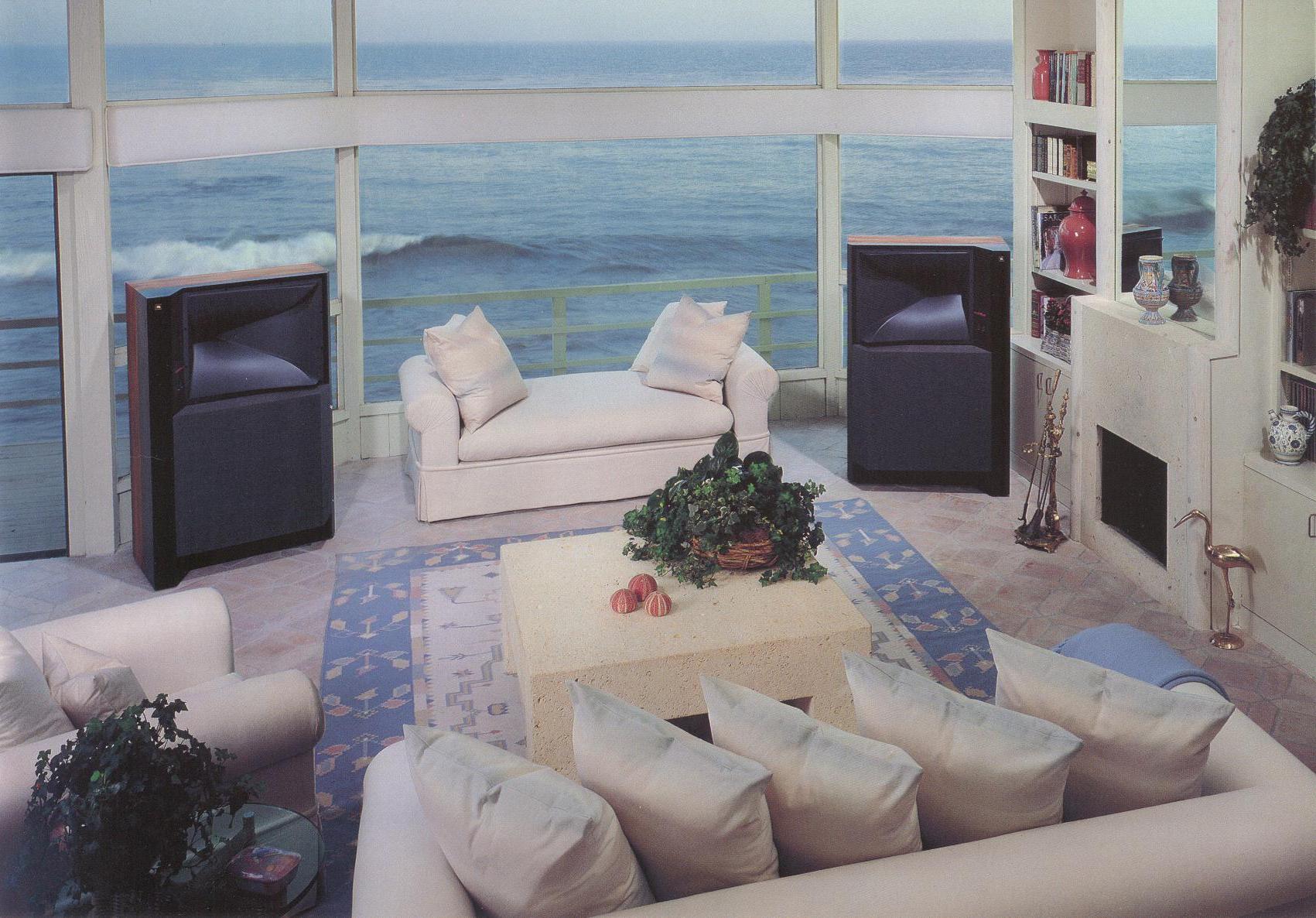
The JBL Everest is a good example of what I'm after. If the Everest cabinet was tilted to cross-fire the speaker, it would take twice as much floor space. But having the waveguide include a built-in angle makes the foot print quite manageable.
Thomas,
Since it is your money, I recommend the most expensive solution.
Art
You sound just like my banker
/Thomas
I have the B&C Speakers DE120 compression drivers ordered. Parts Express is telling me they are back ordered for at least 10 days. Also ordered just one Visaton m10 to measure it and check what the air volume is under the cone. Should get the m10 sometime today. With all my modeling I not convinced that the m10 is better than the Misco RDC3T-A. The issue I see is the m10's response goes too low requiring the woofer to be mounted so far forward that you end up with a horn about the same size as a standard Danley Synergy horn. I'm shooting for something more domestically friendly. The m10 tends to want to go down to about 300Hz. The RDC3T-A only goes down to about 550Hz. When possible I like to use first order crossovers with the acoustical roll off of the driver on the horn. I really don't want to use a higher order crossover to high pass the mids, or a higher order crossover to low pass the woofers to get everything to play together nicely.
JLH,IThe issue I see is the m10's response goes too low requiring the woofer to be mounted so far forward that you end up with a horn about the same size as a standard Danley Synergy horn. I'm shooting for something more domestically friendly. The m10 tends to want to go down to about 300Hz. I really don't want to use a higher order crossover to high pass the mids, or a higher order crossover to low pass the woofers to get everything to play together nicely.
The two way DSL SH 95 uses two 8" drivers in a 13" deep cabinet with the exits near the horn throat, and has +/- 3 dB response 200- 20kHz, -6 dB at 70 Hz, and much smoother phase response than the 22.5" deep three-way SH-50.
Why are you thinking the m10 needs to be "mounted so far forward", and why don't you want to use a higher order crossover?
Art
JLH,
The two way DSL SH 95 uses two 8" drivers in a 13" deep cabinet with the exits near the horn throat, and has +/- 3 dB response 200- 20kHz, -6 dB at 70 Hz, and much smoother phase response than the 22.5" deep three-way SH-50.
Why are you thinking the m10 needs to be "mounted so far forward", and why don't you want to use a higher order crossover?
Art
I wasn't aware of this, so pulled the data.*
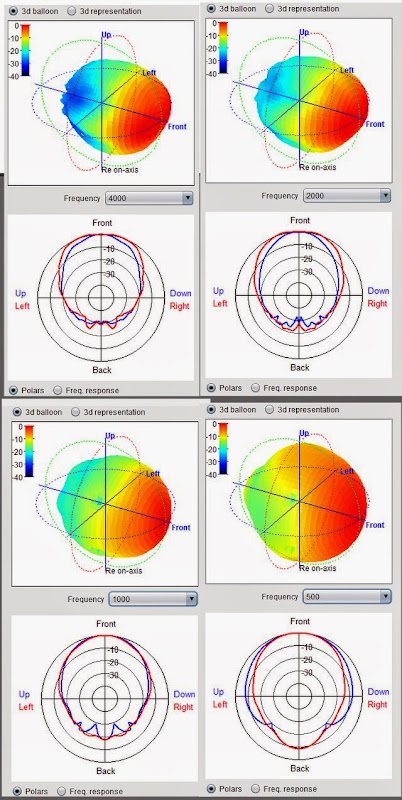
Here's the polars of the SH95. I did one octave pics, at 4000hz, 2000hz, 1000hz, and 500hz. I didn't include 250hz because it's omnipolar at that point; you'd need a 136cm mouth to escape that.
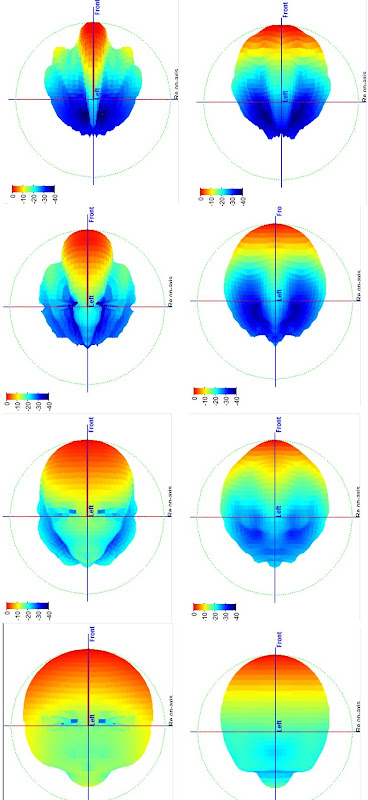
Here's the same data for the Danley SH-50 Synergy Horn and the VTC EL-210 Synergy Horn (with a Paraline.) These are vertical polars for the VTC. (For the Danley it doesn't matter how it's oriented.)
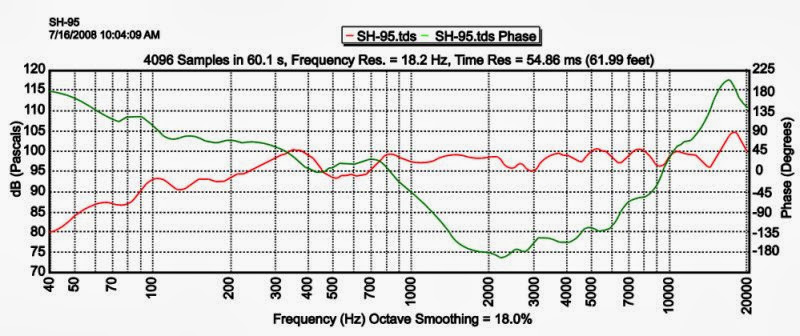
Here's the frequency response and phase of the SH95
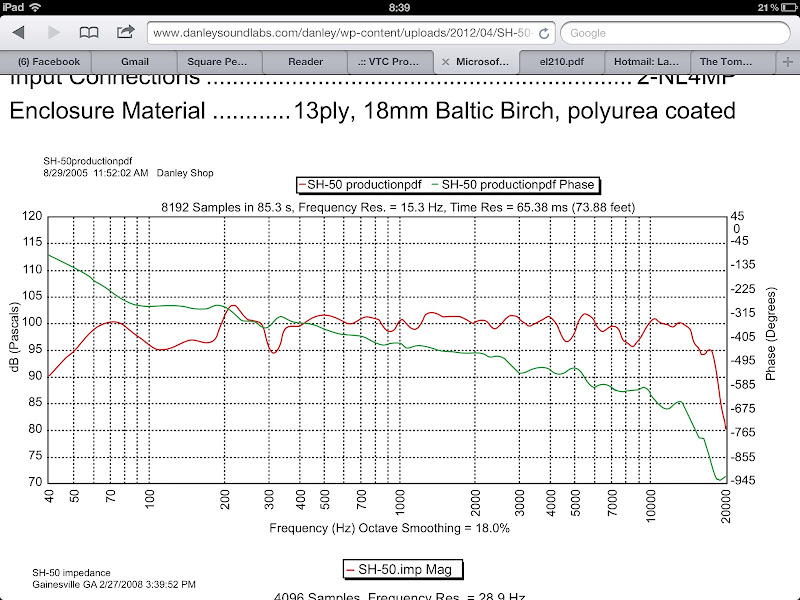
Here's the frequency response and phase of the SH50 (note that the phase scale is completely different than the last pic.)
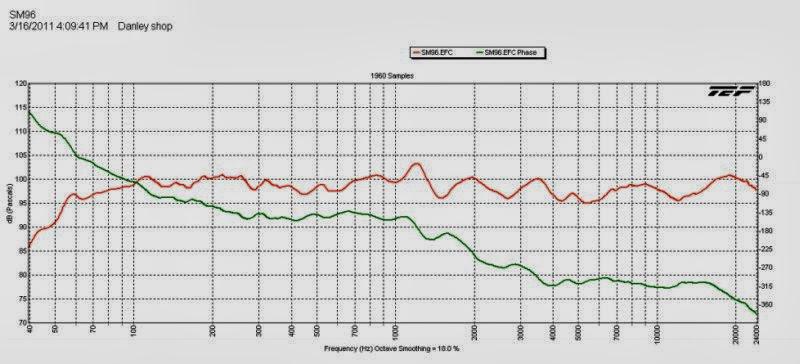
Here's the frequency response and phase of the Danley SM96, which is basically the same format as the SH95. But instead of being a two-way it's a three way.
Am I mising something, or are the molded horns the most 'hifi' here?
From looking at the data, it seems like the Danley SH50 and SM96 have phase response that's superior to the SH95. I think this is because the Synergy horn is unique in the respect that adding drivers can actually improve the phase response. (This is because each driver 'hands off' to the next driver, therefore it's harder to get the phase correct with a two-way than a three way.)
But it seems like the Danley SM96 has frequency response that's a little bit better than the SH50.
If I owned a nightclub I'd probably want the SH50, but it seems like the data indicates that this is the pecking order for home audio:
Danley SM96 > Danley SH50 > Danley SH95 > VTC EL210
I think that size is a big factor for home audio, and here's the sizes for some of these horns:
Sound Physics Labs SPL-Runt Unity horn: 2.5 cubic feet
Danley Sound Labs SM-96 Synergy horn: 5.9 cubic feet
Danley Sound Labs SH-50 Synergy Horn: 11.5 cubic feet
Last edited:
JLH,
The two way DSL SH 95 uses two 8" drivers in a 13" deep cabinet with the exits near the horn throat, and has +/- 3 dB response 200- 20kHz, -6 dB at 70 Hz, and much smoother phase response than the 22.5" deep three-way SH-50.
Why are you thinking the m10 needs to be "mounted so far forward", and why don't you want to use a higher order crossover?
Art
I'm fully aware of all of the Danley offerings and what their specs are. I'm doing a 3-way Synergy horn with a compression driver, four sealed back mids, and a pair of woofers. That is what I'm focused on. In all due respect I'm not interested in other ideas.
You must have misread what I wrote. Its not the mid that needs to be mounted so far forward, its the woofer. We need to get the cancellation notch for the woofer to fall into line with the mid's low frequency roll off. If the mid does not roll off until 300Hz, then the woofer entry ports have to be positioned about 28cm further down the horn than the mid entry ports. This makes for a horn that is more or less the same size as the other 3-way Synergies. The RDC3T-A rolls of around 550Hz, which allows the horn length to be reduced by about 13cm. This will create a domestically more friendly package. I don't want to use higher order crossovers because they involve more parts, present more of a design challenge, and they are more expensive to implement. The goal is to design the horn with the right drivers so that simple low order crossovers can be used.
I think this is because the Synergy horn is unique in the respect that adding drivers can actually improve the phase response. (This is because each driver 'hands off' to the next driver, therefore it's harder to get the phase correct with a two-way than a three way.)
That is exactly what all my simulations have shown me. When I add the woofer and make my horn a 3-way Synergy the phase flattens quite a bit. This really surprised me at first. Glad to see someone else recognize this too.
Few pics of the candidates.
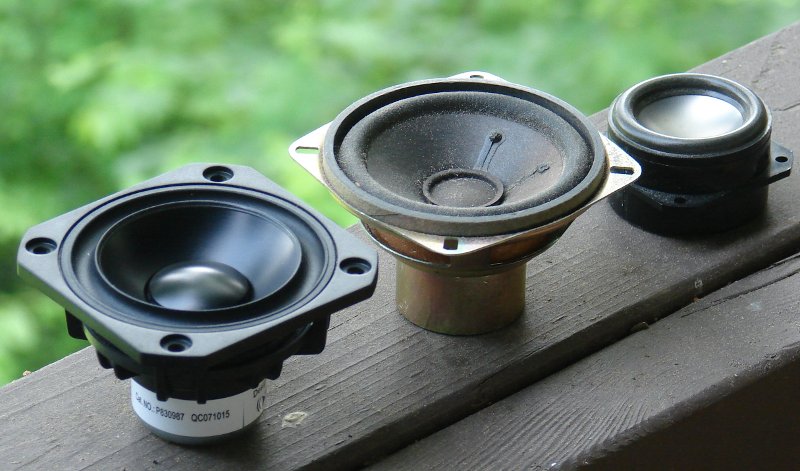
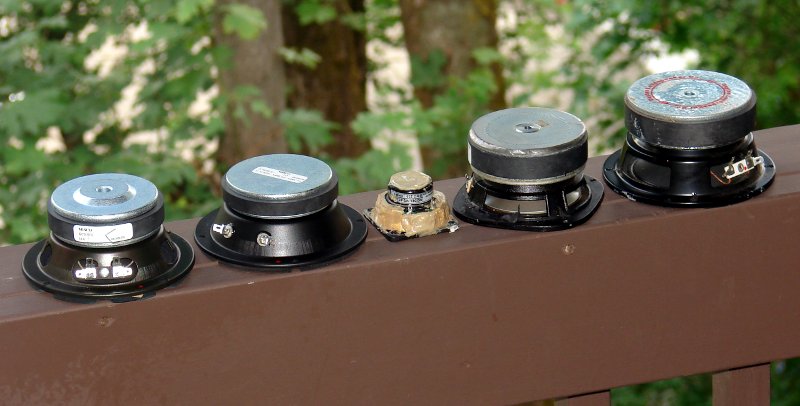
It's scary how many midranges I've tried :O
The 2 way DSL SH-100 has flatter mid-range phase response than the three way DSL Synergies, but as you said "In all due respect I'm not interested in other ideas."That is exactly what all my simulations have shown me. When I add the woofer and make my horn a 3-way Synergy the phase flattens quite a bit. This really surprised me at first. Glad to see someone else recognize this too.
One more for John, so he doesn't out do me by too much. 
B&C Speaker 8PE21-16, Eminence Eminator 1506, Visaton M10-8, Misco RDC3T-A, Tang Band W2-852SH.
Somewhat a disappointment, the Visaton is audibly lower in sensitivity than all the rest. Will have to meter it to see if its my ears playing tricks on me.
The Tang Band W2-852SH works better than what it deserves. Just don't like the rubber surround and the price.
B&C Speaker 8PE21-16, Eminence Eminator 1506, Visaton M10-8, Misco RDC3T-A, Tang Band W2-852SH.
Somewhat a disappointment, the Visaton is audibly lower in sensitivity than all the rest. Will have to meter it to see if its my ears playing tricks on me.
The Tang Band W2-852SH works better than what it deserves. Just don't like the rubber surround and the price.
Attachments
- Also ordered just one Visaton m10 to measure it and check what the air volume is under the cone. [/QUOTE]
John,
How do you measure the volume under the cone?
Do you just measure the outer geometry of the rear chamber, then subtracting the cone volume?
...or do you just cut the thing open, filling it with water, then subtracting the cone volume
/Thomas
John,
How do you measure the volume under the cone?
Do you just measure the outer geometry of the rear chamber, then subtracting the cone volume?
...or do you just cut the thing open, filling it with water, then subtracting the cone volume
/Thomas
What when use a dome mid?
For the 8 inch two way synergy these have a compression driver who go from say 800 Hz
otherwise it will not work wel?
I have done with the FRS-8 a closed box first, with 0.2 liters I get 350 FS 2,40 QTC.
one picture simulated with the changed fs and qtc the other with open back.
I go try with akabak and the script here then I can simulate the whole thing in one go.
regards
kees
For the 8 inch two way synergy these have a compression driver who go from say 800 Hz
otherwise it will not work wel?
I have done with the FRS-8 a closed box first, with 0.2 liters I get 350 FS 2,40 QTC.
one picture simulated with the changed fs and qtc the other with open back.
I go try with akabak and the script here then I can simulate the whole thing in one go.
regards
kees
Attachments
Last edited:
Pour salt on to the cone and level it off. Pour the salt into a graduated cylinder and read the level.- Also ordered just one Visaton m10 to measure it and check what the air volume is under the cone.
Pour salt on to the cone and level it off. Pour the salt into a graduated cylinder and read the level.
I actually use kitchen wrap and water, but I will try salt next time.
But I was really interested in the volume under the cone!
/Thomas
- Home
- Loudspeakers
- Multi-Way
- Suitable midrange cone, for bandpass mid in Unity horn.
